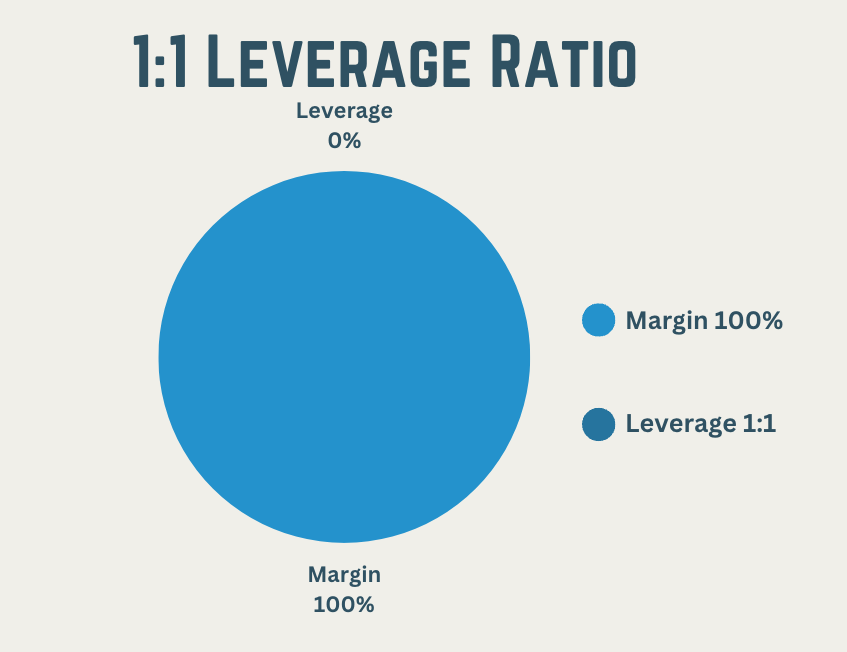Is 1:1 leverage the same as trading the spot market or what is going on here?
With a 1:1 ratio, it is possible to trade without increased buying power and without increased risk-taking.
Most beginners are better off starting in a non-margin environment and in that case, a 1x multiplier could be the best solution.
In this article, we will dive deeper into the topic of 1:1 or 1x which it is also called.
Key takeaways
- 1:1 leverage or 1x means that the trader does not borrow money and is only trading with his own trading capital. This means that if you invest $100, you can only trade with this $100, and no additional funds will be added to your position.
- 1:1 leverage is the lowest ratio possible and it is in essence the same as trading the spot market without borrowed capital which also minimizes the risk. Traders do not have to worry about margin calls or liquidations since there is no extra money added to the positions.
Content table
- 1:1 leverage explained
- Margin requirement
- How to use it effectively
- Examples
- Platforms
- Advantages
- Drawbacks
- How it can affect your losses
- Comparing ratios
- How it affects lot size
- Margin risks and liquidation
- FAQ
- Final words
What does 1:1 leverage mean?

1:1 leverage means that you are not borrowing money to increase your purchasing power. A 1x ratio is the same thing as trading without leverage.
This means that the money that you deposit into your trading account will be the maximum position size for any trades that you open.
A ratio of 1 to 1 means that you don’t have to worry about risks of margin call of full liquidations because you will be trading in the same ways as if you were trading the spot market.
There are no margin requirements
Margin requirement refers to the amount of your own money you need to put down as collateral before opening a leveraged position.
With a 1x ratio, the margin requirement is equal to the entire trade size.
A leverage calculator can be used to calculate margin requirements but it is only necessary at higher ratios.
Let’s say that you want to trade $1000, then your margin requirement would also be $1000. In order words, you will have to deposit the full trade amount no matter how small or large your position is.
We’ve got a guide on how to choose leverage for $1000 that teaches you what ratio is most suitable for this account size.
How it’s used for everyday traders
To use a ratio of 1:1, you should follow these steps:
- Open an account with a trading platform that offers 1:1 ratios.
- Make a margin deposit into your account.
- Choose an asset to trade and choose the 1:1 ratio.
- Select your position size.
- Add your stop loss and take profit order and enter the market.
Our stop loss calculator can be used if you are not sure of your distance to your protective stop.
Not all brokers offer the 1x option so make sure to check this with your operator before making your initial deposit.
Examples of real trades
Assume that you want to trade Bitcoin with a 1x ratio and the price of Bitcoin is currently $25,000. Your account balance is $3000 and you want to invest $1500 in Bitcoin. With a 1:1 ratio, your margin requirement will be the entire trade size, in this case, $1500.
So, from your $3000 account balance, you will need to use $1500 to open this position. If the price of bitcoin would increase to $27,000 your investment would yield an 8% profit, or $120. On the other hand, if the price of Bitcoin would fall to $23,000 your position would suffer a loss of 8%, or $120.
The benefit of using a 1x ratio in this scenario is that the volatility of your PnL will be more stable than if you would trade in high leverage investing.
Some platforms that offer you this
Some brokers and platforms offer 1x ratios in trading, it all depends on what asset class you want to trade.
When you choose a platform it is important to consider the leverage fees and the trustworthiness of the company.
Crypto traders are better off using a crypto broker that provides leverage while forex traders should select a forex broker.
I recommend using a broker that is regulated by a reputable financial authority.
Advantages
The biggest advantage of using a x1 multiplier is that it provides the lowest risk for beginners. It gives you more control over your assets and it is less stressful to trade with.
Another benefit is that you don’t have to worry about margin calls or liquidations. Since you are not using borrowed funds you don’t have a liquidation price.
Most beginners new to margin-traded products are best off starting with a ratio of 1:1 to learn the basics.
Another advantage to using a ratio of 1:1 is that you can invest your money over the long term without worrying about the negative effects of using borrowed money.
Long-term investing with leverage is very beneficial but starting at a 1:1 ratio gives you a lot of breathing room in your portfolio.
Use our stock average price calculator to see your future earnings if you invest without credit and you plan to keep buying in a market that might fall in price.
Downsides
Although a 1x ratio is considered a low-risk trading strategy it still comes with some drawbacks. The most negative part is that it limits your upside and you are not going to be able to see any significant gains in your trading account. This is usually not what traders are expecting when trading with leverage.
If the market goes against you, you will still experience losses. It’s worth mentioning that this is not a risk-free strategy and it is always wise to enter the market with a stop-loss.
It can also be frustrating and straight-out boring if you pick the wrong market that is not very volatile. Most short-term traders will feel stuck if the market is not moving.
How it can affect your losses
Losses are not increased when using a 1x ratio. Your losses will be limited to the amount you have invested in your trading account which is a great benefit for risk-averse traders.
Risk management in trading becomes much more effective when using a lower ratio and it is a good option if you want to build up your confidence before using a high ratio.
If you invest $800 in a forex account and the market goes against you by 1,5%, your loss is going to be limited to the account balance only. In this case, the loss would be $12.
Comparing some ratios for better understanding
1:1 is the lowest ratio available and the next ratio would be 1:2. The difference between 1:1 vs a 1:2 multiplier is pretty significant. At 1:2 credit, it means that you borrow 100% of your current account balance and can double your trade size.
Other higher ratios such as 1:10, and a ratio of 1:100 leverage will dramatically increase both position size and risk.
The profit potential will be 10x and 100x larger but the risk is increased with the same amount. Traders that are using higher ratios need to use proper risk management in trading.
How it affects you lot size, no matter your account size
With 1:1 leverage, you will not be able to trade a larger lot size than your account balance. If you have deposited $800 in your account, this will be the maximum lot size.
The differences between leverage and lot size in Forex are big. Lot size is the number of units for a currency pair while borrowed capital is the active multiplier of your capital.
Since no borrowed money is used at a x1 ratio, your account balance is all the trading capital you will be able to use for your positions.
Can you get margin called or liquidated at this level?
Traders that are using a 1x multiplier will not have to worry about margin calls or liquidation.
Because you are not using borrowed funds, there is extra risk added to your position and the most amount of money you can lose with leverage is your account balance.
For example, if you deposit $500 into your trading account and the market makes a 180-degree turn downwards, the maximum amount you can lose is $500. At such a low ratio you are not affected by leveraged losses.
FAQ
This is the safest option when trading the financial markets. With a 1x ratio, your potential losses are limited to your account capital. Your account balance can never go into debt with 1:1 margin.
Your maximum lot size is equal to your account balance. If you have deposited $2500, then your maximum lot size is $2500.
Yes, it is the same thing as using no borrowed funds at all. There is no borrowed money involved with using this ratio.
It is possible to use a ratio of 1x when trading any asset class such as forex, crypto, stocks and financial spread betting. All you need to do is to make sure that you find a broker that lets you change your ratio to the lowest setting.
Conclusion
1:1 leverage is the lowest ratio you can choose as a trader and it also carries the lowest amount of risk.
While it comes with more control, a 1x multiplier will greatly reduce your profit potential.
Most beginners are advised to start with this ratio to avoid exceeding risk limits.
Keep in mind when you choose a trading platform to look for the option to change your ratio, the fees, and how reliable the platform is.

